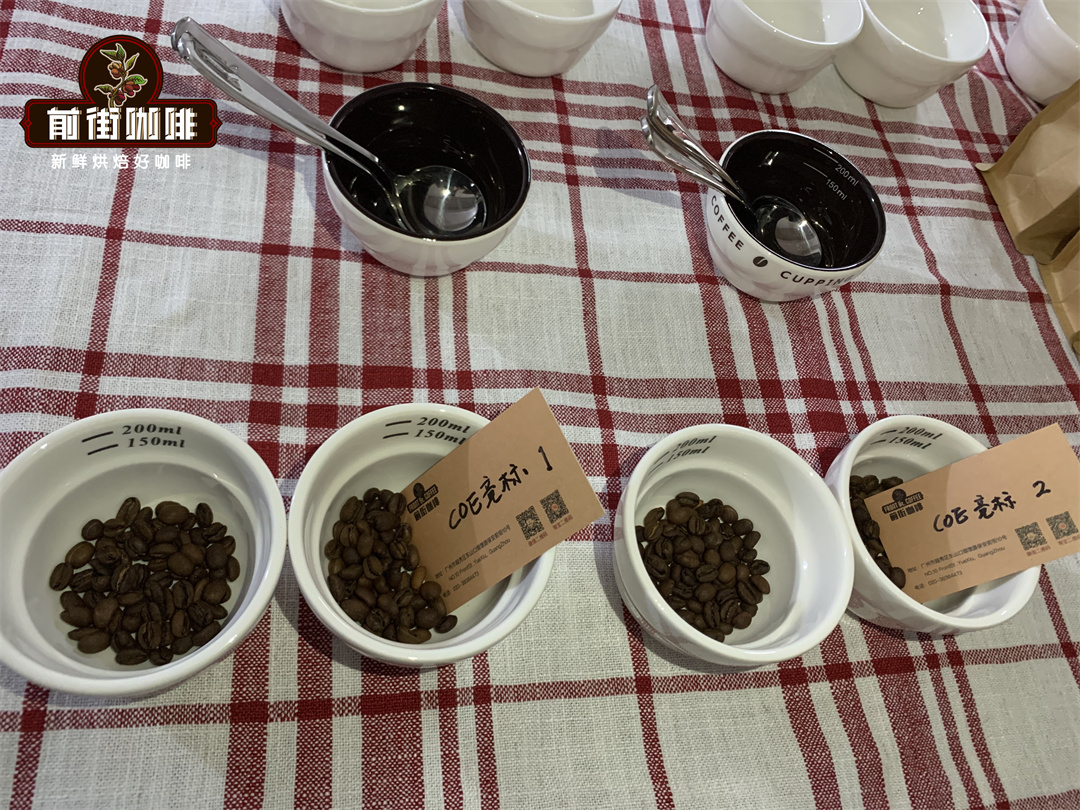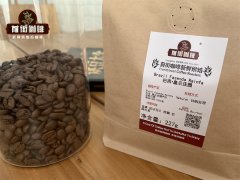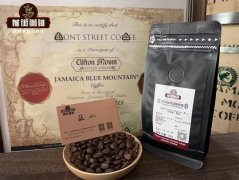Does the coffee cup test produce fine coffee? how does the flavor wheel help the coffee cup test?
In the coffee world, two chefs defined this unique product called coffee: the roaster and the professional barista. Use fire and a roaster to turn dry coffee beans into something completely different. Baristas use his knowledge and experience to "brew" roasted beans, extract aromas from hand-brewed coffee and make the perfect coffee drink.
First of all, anyone can be a good taster. Second, the perfect tool to improve our coffee tasting map is something called a cup test. Qianjie Coffee I believe many people have heard of tasting wine or tea, but today we are going to talk about tasting coffee.
What is a coffee cup test?
One of the conditions for the emergence of boutique coffee is the cup test, which is an independent activity conducted around the world to assess the quality of coffee beans. Similar to wine tasting, cup testing evaluates coffee from different angles: visual analysis, smell, touch and taste.
In addition, this method of evaluating coffee requires tools, such as several sampling roasters, grinders, special cups, electric kettles, cups, taste spoons, and sometimes even colorimeters to determine the degree of roasting.
In short, a cup test is a way to really learn about a particular coffee. You will eventually feel and understand everything from coffee beans to brewing cups of coffee.
As a barista or an avid coffee fan, this is a noteworthy experience and worthy of detailed discussion.
How does the cup test help?
Better taste of coffee, or better taste of anything, can help us all understand what we consume every day.
In general, this coffee evaluation method, known as a cup test, is made by roasters to determine the quality of coffee beans, and one of the best beans is selected by coffee shop owners. And, of course, baristas can better experience coffee and improve its taste.
It can be a unique way to learn about your knowledge of wine and coffee. Besides, it's the perfect way to pick your favorite beans.
So how do you drink coffee?
As I said before, it needs some tools. It's not mandatory to have all of this. That's why I keep it simple, so I'll only give you the most basic tools you need.
Quick tip: you need at least 3 different coffees for cup testing, or at least 3 different ways to bake the same coffee.

Cup testing equipment:
A measuring cup or cup. It is recommended that the cup measuring utensils are glass or ceramic. They should be between 207 and 266 milliliters with matching lids.
Ground coffee. This should be a little thicker than the one commonly used in paper filter drip irrigation. All coffee used should be ground to the same size.
93 C, 200 F, water. Use clean, tasteless water, but not distilled or softened water. The ideal TDS (total dissolved solids) is 125175 ppm, but should not be less than 100 ppm or higher than 250 ppm.
timer. It is very important that the cooking time of coffee powder should not exceed 5 minutes.
Spoon. Some deep spoons are enough.
warm water. This is really important. After each drink, the spoon must be cleaned before the next drink.
Lid. Every cup needs a lid. You can use a small plate.
Preparation for cup test
On the table, line up the cups containing coffee powder. Don't forget to put a note in front of each cup describing the coffee you use to better understand your taste.
Then put the glass containing hot water into the glass for cleaning, and then put the glass into the earth's crust. Prepare spoons and timers.
Pour the coffee powder into the cup. Pour water carefully and set the timer to 4 minutes of brewing time. Put the lid on each cup.
After 4 minutes, break the shell and smell the top of the coffee. Try to remember the smell to judge coffee. Every time you notice something, write it down.
Clean the shell and put it all in a special glass. Now you can start with the interesting part and taste it.
Find a clean spoon. Take a spoonful and taste it. For the best experience, you need to inhale some air into the mouth through the tongue, while the coffee is on the tongue. You're kind of like taking notes out of coffee.
Yes, it's loud, but it's the best way to find the notes.
To get a really thorough analysis, you should taste the coffee at its peak (about 5 minutes) and 10 and 15 minutes to see how it breaks down and how the notes change.
Be sure to take notes of each cup and rinse your mouth with cold fresh water between each cup to keep your mouth clean.
How to taste the coffee
First of all, variety and processing methods are the key: there is a big difference in taste between washed coffee and naturally processed coffee.
Now let's look at some of the main standards and the correct way to describe them.
Taste it. It is used for the basic taste of assets that can be noticed by the tongue. It can be defined as sweet, salty, irritating, nutty, butter, spicy, woody, fruity, wine, astringent, honey, malt, velvet and so on.
Figure. It is judged by the sense of touch in the mouth. It can be described as weak, watery, plump, plump and so on.
Acidity is designed to describe the effect of fruit acid on tasting. They are characterized by liveliness and versatility. It can be sour, fruity, lemon sour and so on.
Flavor assesses the range of aromas and their rhythmic interactions. This is done with the nose, which is why coffee is smelled and spread throughout the mouth during cupping. It can be described as mild, strong, floral, rotten, baked, smooth, creamy, sharp, ash, smoky, medicinal, tobacco-like, fresh and lively, and so on.
The aftertaste provides information about how long the coffee flavor stays in the mouth and whether the aftertaste is pleasant.
Balance defines the interaction between all standards.
The most common considerations
Everyone can come to the conclusion that which is good and which is not satisfactory. But what are we looking for in a cup of coffee? Of course, fresh taste and aroma.
The main notes and the common notes in the cup: sweet, nutty, chocolate, fruity, rich, fresh and smooth, and all the good things. Each cup of coffee should be good on the whole.
However, mistakes occur from time to time. This is why the cup test is carried out in the first place. Make sure the coffee doesn't have a bad taste or taste.
Precautions you should avoid
There is a coffee flavor wheel developed by SCAA that can be viewed correctly. For example, if we talk about sour taste, there are different ways of sour taste, such as sour, hard sour, or strong sour taste. Sour wine may be a good sign in coffee cups, while sour taste is not.
Another good example is sweetness. There are several ways to see this. It can be mellow sweetness, crisp sweetness, sweetness, etc. Of course, the sweet is not a good sign in the cup, but the sweet is.
In terms of aroma (which can be sensed through the nose), there are many ways to determine a cup of coffee. It can be enzymatic, including floral, fruity, herbaceous, or dry distillation, including spicy, resin, carbon, etc.
Of course, if a cup of coffee smells like flowers, it's a good sign, but it doesn't smell like charcoal.
In short, when someone is doing a coffee cup test, good coffee is easy to find. Pepper, acid, pipe, spicy and other flavors should be avoided.
At the same time, vanilla, walnut, apricot, tea rose, coffee flowers and other aromas should be a good sign. Only good coffee can produce such notes.
Important Notice :
前街咖啡 FrontStreet Coffee has moved to new addredd:
FrontStreet Coffee Address: 315,Donghua East Road,GuangZhou
Tel:020 38364473
- Prev

World boutique coffee 5 things you should know about Brazilian boutique coffee
Brazilian coffee has a bad reputation. Quantity is greater than quality, you may hear people say. But there are a lot more beans than most people think. So, as Qianjie Coffee, I'm here to share with you five things you should know about coffee in this country. Some of them may surprise you. The world's largest producer. We're not talking about the country here.
- Next

The sustainable development of boutique coffee what is the relationship between the best boutique coffee and sustainable development
With regard to the future of boutique coffee, we firmly believe that boutique coffee has the potential to thrive in a healthy environment and support the community in a sustainable manner. In order to cultivate a bright future of fine coffee, more and more coffee institutions are committed to pursuing sustainable economic, social and environmental dynamics to protect local and global communities and to establish a more flexible supply of sustainable coffee.
Related
- What brand of black coffee is the most authentic and delicious? what are the characteristics of the flavor of the authentic Rose Summer Black Coffee?
- Introduction to the principle and characteristics of the correct use of mocha pot A detailed course of mocha pot brewing coffee is described in five steps.
- Which is better, decaf or regular coffee? how is decaf made?
- How much is a bag of four cat coffee?
- How about four Cat Coffee or Nestle Coffee? why is it a cheap scam?
- Which is better, Yunnan four Cats Coffee or Nestle Coffee? How about cat coffee? is it a fake scam? why is it so cheap?
- How about Cat Coffee? what grade is a hoax? which instant coffee tastes better, four Cat Coffee, Nestle Coffee or G7 coffee?
- Process flow chart of coffee making-Starbucks coffee making process what coffee tastes good at Starbucks
- The top ten best coffee beans in the world Rose summer coffee or Tanzanian coffee tastes good
- Yunnan four cat coffee is good to drink?_four cat coffee is a big brand? four cat blue mountain coffee is fake?

